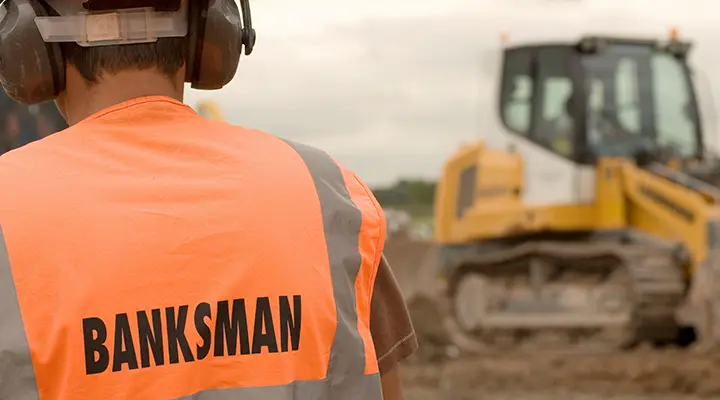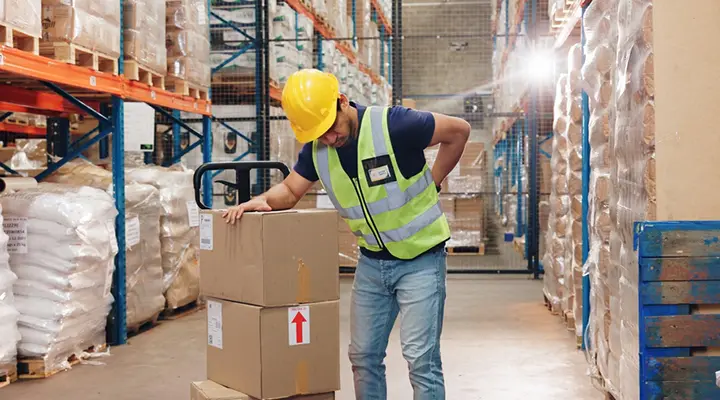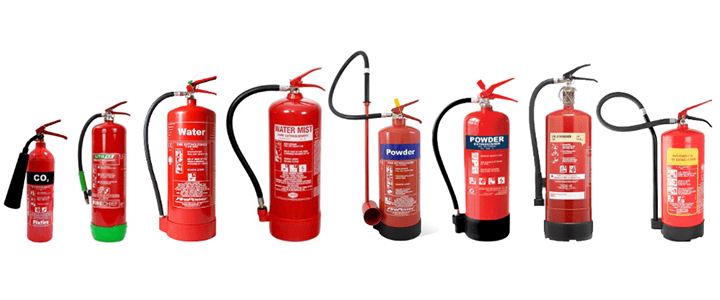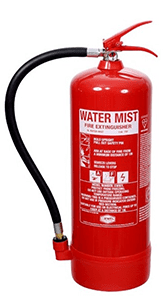Do you know about the different types of fire extinguishers used in the UK? The survey by Fire Industry Association (FIA) reveals that 93% of fires are successfully extinguished using portable fire extinguishers. This is why having the right fire extinguishers in business premises and providing fire extinguisher training to staff is very important. Staff can use the fire extinguishers to put out small fires or create a path to escape safely. They help to protect lives, property and business continuity.
There are several different types of fire extinguishers. Each fire extinguisher is designed to tackle a specific type of fire. Without proper fire extinguisher training, employees may not understand the differences in fire extinguishers. They may try to use the wrong fire extinguisher to put out a fire. This could make the fire worse and increase the risk to their lives and cause greater damage to property.
Here we have listed the main types of fire extinguishers to help you and your employees choose the best and safest type to tackle each incident.
What are the different classes of fire?
Fires are categorised into 5 classes based on the type of fuel that is involved in the fire.

Class A fires
involve freely burning materials including paper, fabric, wood and coal.

Class B fires
involve flammable liquids such as paint, petrol, diesel or turpentine.

Class C fires
involve flammable gases including methane, propane, butane or hydrogen.

Class D fires
involve combustible metals including titanium, potassium, aluminium or magnesium. Combustible metal fires are extremely hazardous and require special fire extinguishers to put them out.

Class F fires
include combustible cooking materials such as cooking oils and fat.

Live electrical equipment fires
do not have a separate class. They fall into one of the classifications depending on the surrounding material that has caught on fire from the electric current. However, fire extinguishers that are suitable to use for live electrical equipment fires have an electric spark symbol.

Lithium-ion battery fires
do not have a separate class. Lithium-ion batteries are extremely flammable and, once on fire, cannot be put out with traditional fire extinguishers or powders.
What are the Different Types of Fire Extinguishers in the UK?
There is no single fire extinguisher that can put out all classes of fire. Fire extinguishers are labelled according to the category of fire they are designed to extinguish.
Click on the picture below to download or print our fire extinguisher chart.
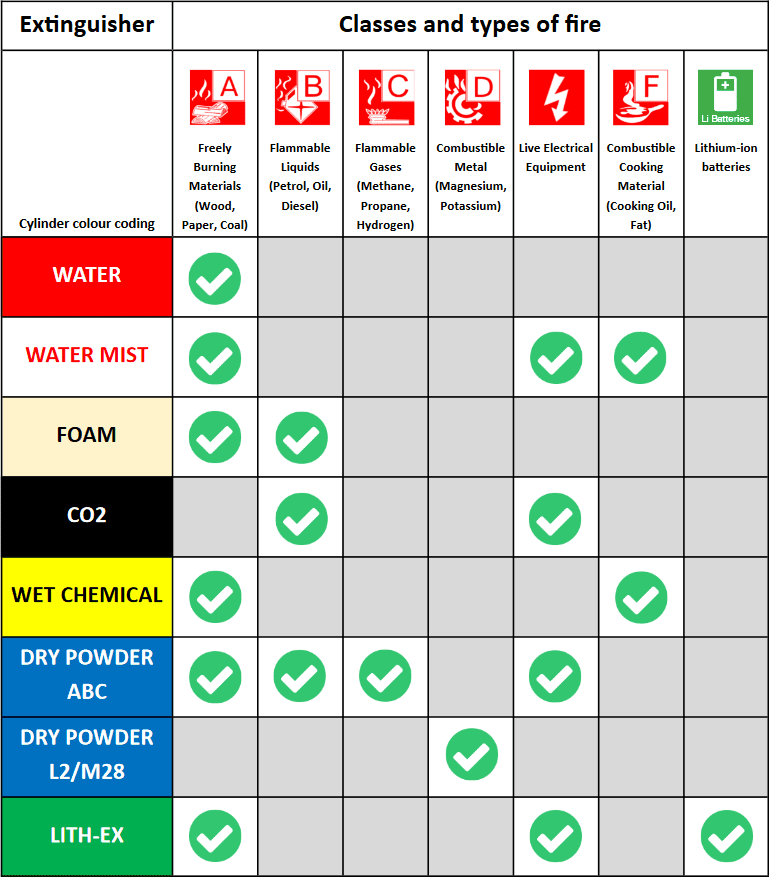

Water fire extinguisher
Water extinguishers dispense water at high pressure to extinguish flames. You should only use them to tackle class A fires, which involve solid combustible materials such as paper, wood, plastics, coal and textiles. Water fire extinguishers can be very dangerous to use for other types of fire. For example, you should never use them to extinguish a Class F fire, which involves cooking oil and fat. Using a water fire extinguisher for a Class F fire can cause an explosion of steam, fire and burning oil. Also, do not use water fire extinguishers to tackle class B (flammable liquids), class C (flammable gases), class D (combustible metals) and electrical equipment fires. Water fire extinguishers are the most common of fire extinguisher type. They are present in most buildings across the UK, including schools, hospitals, office buildings and shops.
Water Mist fire extinguisher
Water Mist fire extinguishers, also known as dry water mist extinguishers, produce a fine water spray. These extinguishers are safe and effective to use on most fires. They can tackle class A fires (wood, paper and textiles) and class F fires (cooking oils and fat). Also, water mist extinguishers contain de-ionised water, so they are safe to use on live electrical equipment up to 1000V from a 1 metre distance. However, you should never use water mist fire extinguishers on class D fires, involving combustible metals.
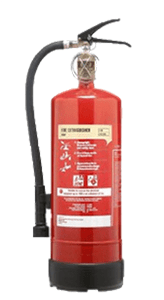
Foam fire extinguisher
Foam fire extinguishers are the most common extinguisher type to use on class B fires, which involve flammable liquids such as petrol and paint. These fire extinguishers are water-based, so they can also extinguish class A (combustible materials) fires. However, do not use foam fire extinguishers on live electrical equipment, class C and class D fires. These extinguishers are present in workplaces that store flammable liquids and combustible materials, for example, schools, warehouses and hospitals. Most buildings should have foam or water extinguishers on the premises.

CO2 fire extinguisher
CO2 fire extinguishers are the primary fire extinguisher to use on live electrical equipment fires. So, you will often find CO2 extinguishers in computer server rooms, offices, and other spaces that contain a lot of electrical equipment. CO2 fire extinguishers can also put out class B (flammable liquids) fires. Do not use these extinguishers on Class A, Class C or Class D fires. However, it is important to remember that you should never use CO2 fire extinguishers in confined small spaces as the CO2 gas quickly replaces oxygen, so it can cause unconsciousness or suffocation. Also, rapid discharge of gas has a freezing effect on the horn, which can freeze the operator’s skin. So, NEVER hold the CO2 fire extinguisher by the horn.
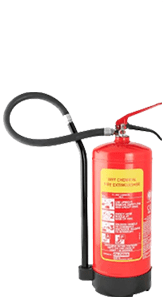
Wet Chemical fire extinguisher
Wet chemical fire extinguishers contain potassium, which is released in a fine mist. You should use wet chemical fire extinguishers to extinguish Class F fires, involving cooking oils and fat. The potassium reacts with the oil and creates a soapy film on the surface of a burning cooking material. Wet chemical fire extinguishers can also put out class A fires. However, foam or water extinguishers are more suitable for extinguishing class A fires. However, do not use wet chemical fire extinguishers on live electrical equipment, class B or class C fires. These extinguishers are present in workplaces with cooking facilities, for instance, commercial kitchens, restaurants and canteens.
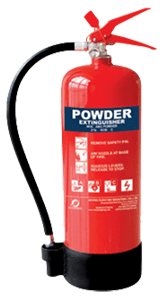
Dry Powder ABC fire extinguisher
Dry Powder ABC fire extinguishers are very effective for use in mixed risk environments. They coat the fuel with a thin layer of dust and interrupt the chemical reaction of fire. Dry Powder ABC fire extinguishers can put out class A, class B, class C and live electrical equipment fires. It is also the only effective solution for fires involving flammable gases. However, do not use dry powder ABC fire extinguishers on class D fires or any fires that start in enclosed spaces as the powder can be easily inhaled. These extinguishers are present in garages, welding business premises or large boiler rooms.

Dry Powder L2/M28 fire extinguisher
Dry Powder L2 and M28 fire extinguishers are specifically designed to tackle class D burning metal fires. They mostly occur in industrial, manufacturing, or laboratory settings. The L2 fire extinguishers can tackle class D burning metal fires including lithium. However, you should NOT use the M28 fire extinguisher on fires involving lithium. Dry Powder L2/M28 fire extinguishers are the only types of fire extinguishers that can put out burning metal fires. However, they are not effective for any other class of fire.
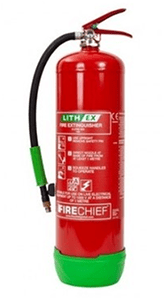
Lith-Ex fire extinguisher
Lith-ex fire extinguishers are specially designed for use on lithium-ion batteries. Lithium-ion batteries are sensitive to heat and extremely flammable. You cannot put out a lithium battery fire with traditional fire extinguishers or powders. Lith-ex fire extinguishers are the safest and most effective way to put out lithium battery fires. These extinguishers can also put out Class A and live electrical equipment fires. However, you should never use Lith-ex fire extinguishers on class B or class F fires.
Who is responsible for taking care of fire extinguishers?
It will vary based on the business. In some instances, checking the dates and such will be the responsibility of your Fire Marshal/Warden. If you’re working in a business without one, we recommend that someone participate in Online Fire Marshal Training to get certified.
Need Fire Safety training?
We offer the following RoSPA-assured and CPD-certified online Fire Safety training courses:
1 – Online Fire Safety Awareness Training
2 – Online Fire Marshal / Warden Training
3 – Online Fire Extinguisher Awareness Training
Need some advice?
Get in touch if you have a question and one of our team will be happy to help. You can get in contact at 0333 577 5016 or sales@i2comply.com. We are always here to help and answer any questions.
